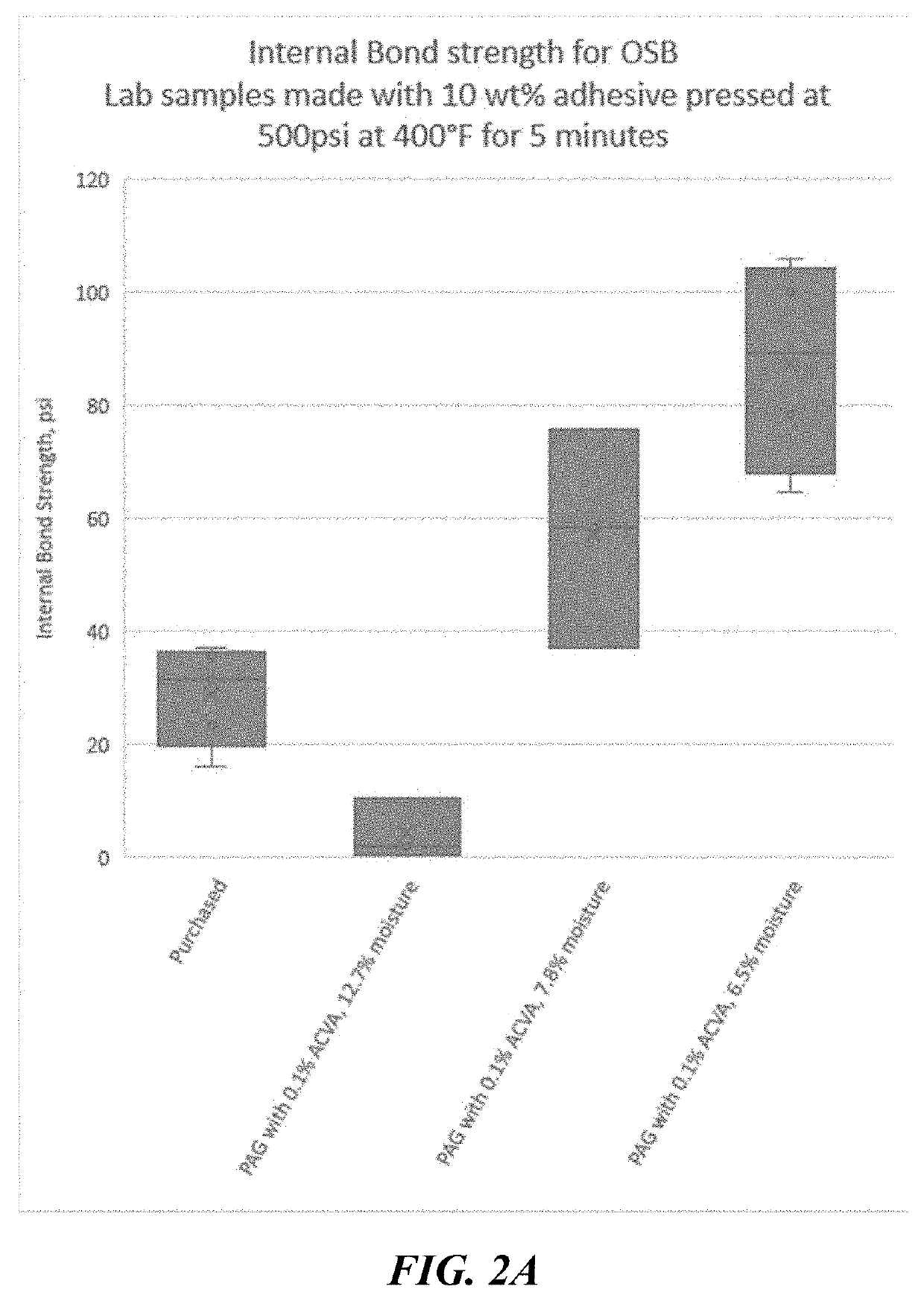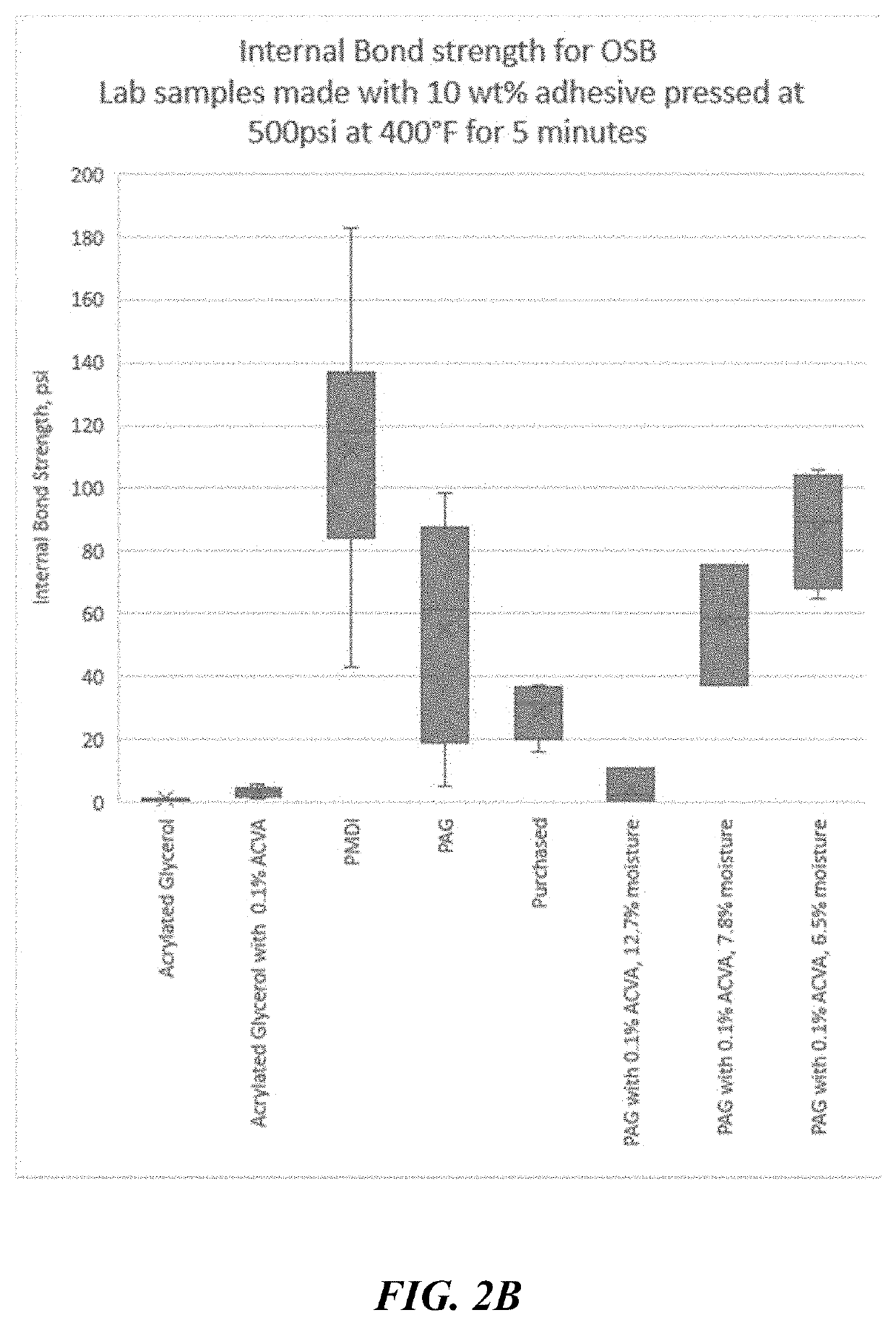Thermoplastic poly acrylated glycerol adhesives useful in cellulosic products
a technology of acrylated glycerol and adhesives, which is applied in the direction of adhesive types, other domestic objects, woodworking apparatuses, etc., can solve the problems of reducing the throughput of the manufacturing process, wasting energy, and long residence times, and achieves less fiber tear and clean machined surfaces.
- Summary
- Abstract
- Description
- Claims
- Application Information
AI Technical Summary
Benefits of technology
Problems solved by technology
Method used
Image
Examples
example 1
ed Acrylated Glycerol Production
[0086]The materials were mixed in the following order: 10 kg glycerol was slowly added to 10.43 kg Acrylic acid, 470 g Hydroquinone, and 1.50 kg Triphenylphosphine. The solution was heated to 125° C. while stirring and with a reflux column and stirred with heating for 36 hours. This resulted in a glycerol with an average of 1.2 acrylic groups per molecule.
[0087]The acrylated glycerol was polymerized by adding 5.55 kg acrylated glycerol, 23 kg methanol, 27.75 g Azobisisobutyronitrile, and 0.5772 g Ethyl (3-oxo-2-butanyl) carbonotrithioate into a reactor, purging with argon gas and then reacting at 71° C. for 8 hours. The polymer was precipitated out in a 2-propanol solvent and then decanted and dried. This resulted in a 54% yield of polymer product.
example 2
ated Glycerol Oriented Strand Board
[0088]PAG made to a target molecular weight of 2 Mda was diluted to 33 wt % solids in water with 0.1 wt % 4,4′-Azobis(4-cyanovaleric acid) added as a free radical thermal initiator. 10% wt. of polyacrylated glycerol was then applied with a HVLP sprayer onto wood strands tumbling in a rotating mixer. 233 grams of adhesive coated strands were then pressed in a 7″×7″ form and next pressed in a Carver hot press at 400 psi and 400° F. (204° C.). Subsequent polyacrylated glycerol samples were prepared as above, but with the adhesive coated strands dried to lower moisture levels.
[0089]PMDI oriented strand board samples were made by applying 10% wt. of PMDI Rubinate 1840 with a HVLP sprayer onto wood strands tumbling in a rotating mixer. 220 grams of adhesive coated strands were then pressed in a 7″×7″ form and next pressed in a Carver hot press at 400 psi and 400° F. (204° C.)
[0090]Internal Bond Strength (IBS) was determined using an Instron universal tes...
example 3
ated Glycerol Adhesive Overlap Shear Tests
[0094]To determine the strength of the PAG—wood adhesive bond, overlap shear samples were prepared to ASTM D-905 specifications. Several samples had shear strengths over 10 MPa as shown in FIGS. 3A-B.
PUM
| Property | Measurement | Unit |
|---|---|---|
| molecular weight | aaaaa | aaaaa |
| molecular weight | aaaaa | aaaaa |
| Tg | aaaaa | aaaaa |
Abstract
Description
Claims
Application Information
 Login to View More
Login to View More - R&D
- Intellectual Property
- Life Sciences
- Materials
- Tech Scout
- Unparalleled Data Quality
- Higher Quality Content
- 60% Fewer Hallucinations
Browse by: Latest US Patents, China's latest patents, Technical Efficacy Thesaurus, Application Domain, Technology Topic, Popular Technical Reports.
© 2025 PatSnap. All rights reserved.Legal|Privacy policy|Modern Slavery Act Transparency Statement|Sitemap|About US| Contact US: help@patsnap.com



